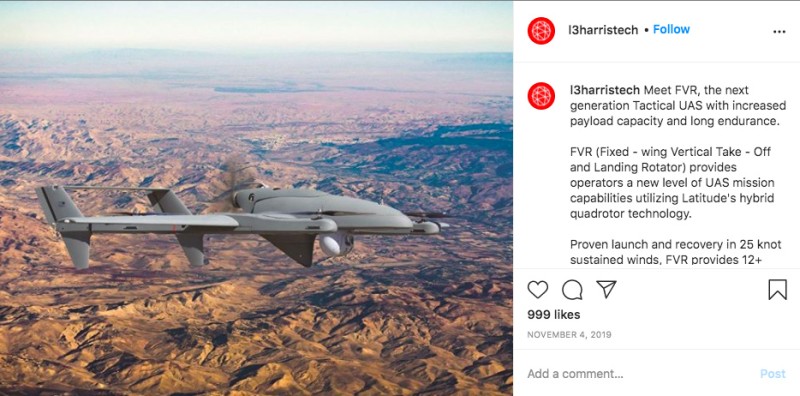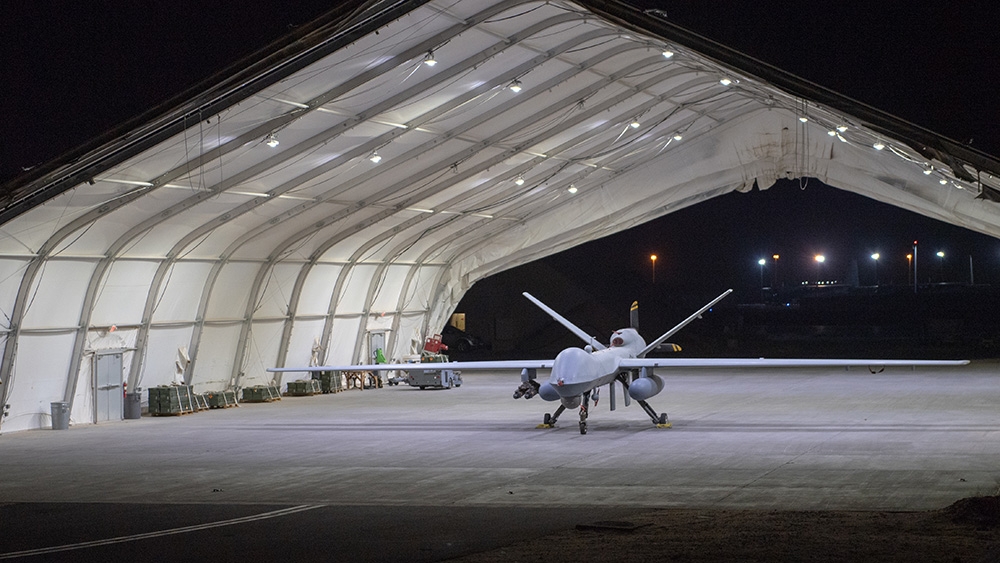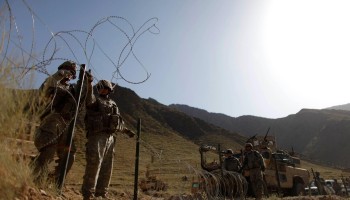It was early on a Sunday morning when Al-Shabab militants attacked the small airstrip next to a military base on Kenya’s north coast. Plumes of black smoke billowed into the sky as the militants destroyed six aircraft and killed three Americans, including two civilian contractors and one U.S. soldier.
In the wake of the January 5 attack, Fahim Twaha, the governor of Lamu County where Camp Simba is located, described the incident as “a foreign force attacking a foreign force on our soil.”
The U.S. military had been using the base, nestled in the normally sleepy Manda Bay, for East African operations for over a decade. The American presence, as well as the base, has expanded over the years, including the recent addition of new aircraft hangars, likely to protect sensitive technology installed on surveillance aircraft. In 2019, the U.S. mission at Camp Simba officially changed from “tactical” to “enduring operations.”
Now an investigation by OCCRP reveals that the U.S. military has been using the Kenyan base as a launchpad for surveillance aircraft supporting airstrikes in neighboring Somalia, with civilian contractors playing a pivotal role by providing intelligence on targets.
Flight data indicates a contractor-owned plane that was seen regularly in Manda Bay scouted sites for several drone strikes against Islamist militant group Al-Shabab that may have killed civilians in Somalia. Data collected by an antenna installed by OCCRP confirmed multiple privately owned surveillance planes operated from the base, often hidden behind a chain of limited liability companies that do not list their true owners.
Sean McFate, a former private military contractor now working with the Washington-based think tank Atlantic Council, said that in the past companies were brought in to help analyze U.S. military data, but not collect it.
“The ethical standard of who can pull the trigger has been slowly eroding over the last 30 years," he said, explaining that even if private contractors are not involved in combat, they become “part of the kill chain” by providing intelligence for airstrikes.
“If they’re doing lethal operations, then I think we’ve crossed a threshold,” McFate said.
Pulling the Trigger
U.S. Africa Command (AFRICOM) said the use of contractor pilots for intelligence, surveillance, and reconnaissance missions is legal under domestic and international law. The public affairs office declined to confirm details or comment on specific aircraft and companies identified by OCCRP, citing operational security.
The U.S. military ramped up airstrikes in Somalia following the attack at Manda Bay, carrying out 42 by mid-2020, compared to 63 recorded in all of 2019.
Battleground Kenya
U.S. security services started to focus on Kenya following the 1998 bombing of the U.S. Embassy by Al Qaeda in Nairobi that killed 213 people. It was around this time that early iterations of Al-Shabab were developing north of the border, in Somalia, where the group still aims to establish an independent Islamic state.
Satellite images of the runway at Camp Simba in Manda Bay in February 2018 and April 2019.
‘Constant Fear’
Last year, Asha Hassan, a mother of seven, left her home in Lower Shabelle, the region in Somalia most targeted by U.S. airstrikes. She and her children are among 1,300 families that have settled in the makeshift Alla Futo camp on the outskirts of Mogadishu. Another 36,000 people fled the region in the first three months of 2020, nearly all because of the conflict, according to the UN’s refugee agency.
“We fled from the planes that were hovering over us every night. These planes can drop things any time,” Hassan said. “We could not live there. We fled due to those problems and the constant fear.”
The U.S. first launched airstrikes against Al-Shabab in Somalia in 2007 and increased them significantly in 2016, according to data collected and analyzed by U.K.-based non-profit Airwars. They have ramped up again substantially since U.S. President Donald Trump loosened the rules of engagement three years ago.
Thousands of people have been killed by U.S. airstrikes in Somalia since 2007, including as many as 145 civilians, according to Airwars. The U.S. military only acknowledges five accidental civilian deaths since 2017. It’s unclear if there was a review of alleged civilian deaths over the previous decade.

Alla Futo camp on the outskirts of Mogadishu. Credit: Mohamed Ibrahim Bulbul.
OCCRP’s investigation indicates that at least some of those drone strikes were based on intelligence gathered by private U.S. contractors operating out of Manda Bay.
OCCRP used flight tracking data and matched it to geo-coded airstrike data from Airwars, which also collects information on civilian casualties from official military statements, as well as media reports, NGOs and social media. The group cross-references claims of civilian casualties to try to confirm them, but notes that “we are often unable to follow up or to further verify such claims.”
On February 1 and 5, 2019, a contractor-owned Gulfstream jet flew repeatedly over a small area in Lower Shabelle, about 30 kilometers west of Mogadishu. It returned to the area on March 9. The plane had a particular flight pattern — near-perfect circles — and was likely collecting data with its specialized sensors, according to experts on the subject.
On February 6 and 11, and again on March 11, U.S. airstrikes hit areas the plane apparently surveyed. AFRICOM said 11 militants were killed in the first strike near the ancient seaside town of Gandarshe, which was directly below the Gulfstream’s flightpath.
Two more strikes were launched on Feb. 11 near Janaale, about 20 kilometers from the first drone attacks, again right under the Gulfstream’s flightpath. The U.S. military claimed that 12 militants were killed and no civilians — although reports collected by Airwars claim 13 civilians had died.
On March 9, the Gulfstream flew over a spot just kilometers northwest of Tuwaareey, which was hit by an air strike two days later. AFRICOM said eight militants were killed and that Al-Shabab was using the area to “direct terror attacks, steal humanitarian aid, extort the local populace to fund its operations, and shelter radical terrorists.” Information collected by Airwars, however, concluded that between one and seven civilians may have died.
A report released by AFRICOM this spring confirmed two civilian deaths in a separate strike that took place on February 23, 2019.
The Gulfstream aircraft that appears to have collected surveillance for these attacks was spotted near Manda Bay on several occasions. It’s registered to a company called AC-1425 LLC, a nod to the plane’s serial number. According to U.S. Federal Aviation Administration filings, it also belongs to Priority 1 Holdings LLC.
Incorporated in Delaware in 2017, Priority 1 has intimate links to the U.S. security establishment. Its former CEO, Andrew Palowitch, held two official postings at the Central Intelligence Agency and was director of the Space Protection Program, sponsored jointly by the U.S. Air Force and the U.S. National Reconnaissance Office. He also held executive positions at Science Applications International Corporation (SAIC), one of the most profitable contractors in the U.S. defense industry, and Tenax Aerospace Holdings, an intelligence and defense contractor that boasts a former CIA Director and a former commander of U.S. Special Operations Command as board members.
Priority 1’s website says the company’s aviation operations are conducted through its subsidiary, AIRtec Inc., an “airborne services company” that had over US$10 million in government contracts in the past year. AIRtec lists the same model Gulfstream aircraft that may have gathered intelligence for the U.S. airstrikes in its fleet.
It’s unclear which U.S. government agency contracted Priority 1 or AIRtec for work in East Africa, or whether the aircraft was leased to another contractor.
When registering the plane, the company listed its address at a renovated $640,000 Florida condo with coastal views and quartz waterfall counters, and a phone number in Ireland.
The company bought the Gulfstream aircraft in 2018, and AIRtec promptly modified it to perform specialized missions, equipping the plane with camera and communications equipment suitable for military surveillance. They included a radar system that “can peer through foliage, rain, darkness, dust storms or atmospheric haze to provide real time, high quality tactical ground imagery, anytime it is needed, day or night,” according to a brochure from the manufacturer, Lockheed Martin.
Palowitch and Priority 1 declined to respond to detailed questions for this article, including whether the aircraft has conducted target surveillance over Somalia. Greg Kahn, general counsel for Priority 1, said the “questions are not appropriate for our company to be discussing.”
“This subject matter, as I am sure you are aware, is highly confidential,” Kahn said in an email.

OCCRP obtained a photo from the cockpit of a surveillance plane operated by contractors based at Manda Bay, then used Google Earth satellite imagery to identify the aircraft's location on the Somali coast. Credit: Samir.
The Big Safari
Some of the companies operating in Manda Bay are contracted under the auspices of the secretive U.S. Air Force program named Big Safari, which was started to fast-track Cold War surveillance technology in 1952.
Critics say Big Safari’s opaque contracting process, which has awarded almost $158 billion to private companies since 2008, is vulnerable to corruption as it bypasses normal procurement procedures. They say contracts have been awarded to companies run by well-connected executives, including former military and intelligence officials, rather than dispensed through a competitive bidding process.
“The Air Force remains satisfied that the acquisition practices utilized by Big Safari are in accordance with the Federal Acquisition Regulation, Department of Defense Federal Acquisition Regulation Supplement, applicable Department of Defense Instructions, and Air Force guidance governing acquisition programs,” a public affairs officer said in an email.
One company that has faced accusations is L3Harris Technologies, which employed the two contractors killed in January and operated a surveillance plane that was destroyed in the attack. It is the top vendor of the Big Safari program, and government data shows that L3Harris won $4 billion in federal government contracts during the last U.S. federal fiscal year, which ended on September 30, 2019.
In 2017, before L3 merged with Harris Corporation, two Republican congressmen published an open letter alleging there was a “revolving door” of people moving between the military and L3. The representatives from North Carolina, Ted Budd and Walter Jones, said the company used “improper influence” over the contracting process to sell aircraft for use by the government of Yemen in the country’s ongoing civil war, with no competitive bidding process. They argued more cost-effective planes were available (including some made by a company in Budd’s district) and the Big Safari official in charge of steering the deal later resigned and went to work for L3. The Washington-based Project On Government Oversight notes in its Pentagon Revolving Door Database that L3 has hired several senior defense officials.
The company also made headlines that year, when prominent Kenyan anti-corruption advocate John Githongo and Congressman Budd called for an investigation into its role in a deal to sell armed surveillance aircraft to Kenya. They accused Kenyan officials of corruption, though a U.S. government investigation found no wrongdoing on the part of the Air Force program.
L3Harris continues to be a favored U.S. contractor. In a May 5 call with investors, executives said the firm had been buoyed by its close relationship with Big Safari at a time when many companies have been struggling with the impact of the coronavirus pandemic.
"One highlight was over $800 million in award activity from our leading position on the Big Safari programs," said COO Chris Kubasik.
No one on the call mentioned L3Harris contractor Bruce Triplett, 64, or pilot Duston Harrisson, 47, who were killed during the attack in Manda Bay, when militants fired a rocket-propelled grenade into the plane they were taxiing along the air strip. Another contractor was badly injured but crawled to safety, the New York Times reported, while Army Specialist Henry Mayfield Jr., 23, was also killed.
Stephen Townsend, head of AFRICOM, told the U.S. Senate that Triplett and Harrisson “died while protecting the American people from the very real threat of Al Qaeda and Al-Shabab terrorist groups.”
But McFate noted the difference in response to the attack and the 1993 “Black Hawk Down” incident in Somalia, when the deaths of 19 American soldiers prompted the U.S. to withdraw from the country.
“Americans do not care about dead contractors,” McFate said. “They care about dead soldiers, like Black Hawk Down, but nobody cares at all about a dead contractor.”
Another Big Safari contractor that had a prominent presence at the base in Manda Bay is AEVEX Aerospace, a company that operates contractor-owned planes in Africa for intelligence, surveillance, and reconnaissance.
Formed in 2018 from three smaller defense companies and led by a former U.S. Special Operations Command officer, the firm won federal contracts worth $44 million in 2019. It also recently landed a classified contract to provide civilian pilots for operations in West Africa, according to the Paris-based news site Africa Intelligence. The pilots will operate MQ-9 Reaper drones and other intelligence-gathering aircraft.
AEVEX has advertised positions that would “interface with intelligence and operations elements” in Africa and operate surveillance equipment. In one ad, the company said its analysts are expected to build “patterns of life” and target descriptions, as well as conduct battle damage assessment.
At least two aircraft owned by subsidiary limited liability companies, but ultimately traced to AEVEX, have been spotted in Manda Bay. One is a helicopter with specialised equipment; the other is a Pilatus plane that had medical beds installed and the flight data recorder removed in 2018. The Pilatus has made multiple trips over Somalia, flight data shows.
L3Harris and AEVEX did not respond to repeated requests for comment.
Global Investors
‘Addicted to Contractors’
The situation at Camp Simba in Manda Bay is a microcosm of conflicts around the world in which the U.S. has come to increasingly rely on contracting military and intelligence operations to private companies.
Experts say a lack of publicly available information makes it hard to count the number of contractors involved in military operations, but their roles have dramatically increased since the 1990s when such duties fell almost exclusively to military personnel.
“The U.S. government has become addicted to contractors, whether they are Republicans or Democrats in the White House, because contractors give you some degree of plausible deniability,” said McFate.
The military says contractors allow for greater flexibility. “Resource constraints, unique requirements, and military manpower caps are just some of the reasons that make it necessary to augment military forces via contract or federal hiring action in order to accomplish the mission,” an AFRICOM public affairs officer said in an emailed statement.
Last year, the Pentagon spent $370 billion — more than half the U.S. defense budget — on contractors, according to a [study](https://watson.brown.edu/costsofwar/files/cow/imce/papers/2020/Peltier 2020 - Growth of Camo Economy - June 30 2020 - FINAL.pdf) by Brown and Boston universities. The researchers concluded “military contracting is at least as expensive, and often more expensive” for the government. McFate even suggests that because profit is an incentive for private companies, the practice may prolong wars.
Analysts question whether the money pumped into America’s war in Somalia has improved, or worsened, security in the country.
Following the Manda Bay attack, Air Force Col. Christopher Karns said that airstrikes “don’t provide a long-term solution to the terror problem,” but they “create organizational confusion in the ranks of Al-Shabab and an effective punch.”
Hussein Sheikh Ali, chairman of Mogadishu-based think tank Hiraal Institute and a former national security adviser to the current Somali president, warned the drone attacks could be backfiring.
Rather than weakening Al-Shabab, he said, the tactic strengthens the militant group, as drone strikes alienate civilians by destroying property, lives, and livelihoods. The drone war also allows Al-Shabab to frame the conflict as a struggle against an invading foreign power.
“After Manda Bay, it’s looking like a conflict between Al-Shabab and America — and that’s actually what Al-Shabab wants,” Ali said. “Al-Shabab wants to be seen that they are fighting a global superpower.”
AFRICOM acknowledges that the airstrikes may be used against U.S. interests, but dismisses the concern.
“Al-Shabab has repeatedly shown that they are willing to lie and use false propaganda to further their goals in Somalia, regardless of what the U.S. does,” a public affairs officer said in an emailed statement.
“When assessing Somalia, it is important to understand incremental progress has been made over the last decade as the result of a truly international effort inside the country,” they added.
Margot Williams, Carolyn Thompson, Katarina Sabados, Maria Gargiulo, Abdalle Mumin, Will Swanson, Mohamed Ibrahim Bulbul, Carlo Muñoz, Jared Ferrie, Juliet Atellah, and others who wish to remain anonymous contributed reporting. This story was produced with support from the Fund for Investigative Journalism and Freelance Investigative Reporters and Editors.










